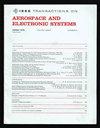为双功能雷达和通信系统设计具有所需振型的稀疏线性阵列的高效算法
IF 5.7
2区 计算机科学
Q1 ENGINEERING, AEROSPACE
IEEE Transactions on Aerospace and Electronic Systems
Pub Date : 2024-12-18
DOI:10.1109/TAES.2024.3519492
引用次数: 0
摘要
在本文中,我们讨论了在双功能雷达和通信(DFRC)系统中设计具有定义波束方向的稀疏发射阵列的问题。主要目标是设计一种稀疏发射天线阵列,使发射波束的大量功率集中到期望的目标上,同时向多个通信用户传输信息。为了解决这一问题,提出了两种基于最大-最小法(MM)和交替投影法(MAP)的迭代算法。这两种算法都处理简单的最小二乘拟合问题,最小化合成功率图与期望功率图之间的绝对或绝对平方误差。上述优化问题是在设计的阵列工作在最大功率和发射波束的所有副瓣严格低于指定阈值的约束下解决的。此外,所设计的阵列可以将嵌入在发射波束旁瓣的信息以调制符号的形式传输给多个用户,从而保证了通信子系统的可靠性能。通过在设计目标中加入促进正则化的稀疏性项来实现数组的稀疏性。通过各种数值模拟,我们从收敛性、匹配均方误差和设计的发射天线阵列的稀疏性等方面说明了所提方法的性能。本文章由计算机程序翻译,如有差异,请以英文原文为准。
Efficient Algorithms for Designing Sparse Linear Arrays With Desired Beampattern for Dual-Function Radar and Communication Systems
In this article, we address the problem of designing a sparse transmit array with a defined beampattern for applications in dual-function radar and communication (DFRC) systems. The main objective is to design a sparse transmit antenna array such that the bulk power of the transmit beam is concentrated towards the desired target along with the simultaneous transfer of information to multiple communication users. To tackle the problem, two iterative algorithms based on the majorization–minimization (MM) method and the method of alternating projections (MAP) are proposed. Both the proposed algorithms deal with solving the simple least squares fitting problems, minimizing either the absolute or absolute squared error between the synthesized and desired power pattern. The aforementioned optimization problems are solved under the constraints that the designed array operates at maximal power and all the sidelobes of the transmit beam are strictly below a specified threshold. In addition, the designed arrays can transmit the information embedded in the sidelobes of the transmit beam in the form of modulated symbols to multiple users, thereby ensuring the reliable performance of the communication subsystem. The sparsity of the array is achieved by adding the sparsity promoting regularization term in the design objectives. Through various numerical simulations, we illustrate the performance of the proposed approaches in terms of convergence, the matching mean square error, and the sparsity of the designed transmit antenna array.
求助全文
通过发布文献求助,成功后即可免费获取论文全文。
去求助
来源期刊
CiteScore
7.80
自引率
13.60%
发文量
433
审稿时长
8.7 months
期刊介绍:
IEEE Transactions on Aerospace and Electronic Systems focuses on the organization, design, development, integration, and operation of complex systems for space, air, ocean, or ground environment. These systems include, but are not limited to, navigation, avionics, spacecraft, aerospace power, radar, sonar, telemetry, defense, transportation, automated testing, and command and control.

 求助内容:
求助内容: 应助结果提醒方式:
应助结果提醒方式:


